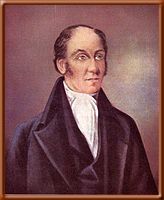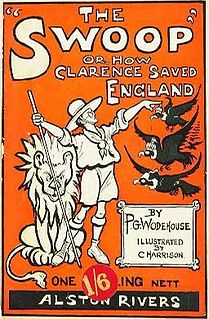
William Maxwell Aitken, 1st Baron Beaverbrook, PC, ONB, generally known as Lord Beaverbrook, was a Canadian-British newspaper publisher and backstage politician who was an influential figure in British media and politics of the first half of the 20th century. His base of power was the largest circulation newspaper in the world, the Daily Express, which appealed to the conservative working class with intensely patriotic news and editorials. During the Second World War, he played a major role in mobilising industrial resources as Winston Churchill's Minister of Aircraft Production.

Timothy Hackworth was an English steam locomotive engineer who lived in Shildon, County Durham, England and was the first locomotive superintendent of the Stockton and Darlington Railway.

William Tufnell Le Queux was an Anglo-French journalist and writer. He was also a diplomat, a traveller, a flying buff who officiated at the first British air meeting at Doncaster in 1909, and a wireless pioneer who broadcast music from his own station long before radio was generally available; his claims regarding his own abilities and exploits, however, were usually exaggerated. His best-known works are the anti-French and anti-Russian invasion fantasy The Great War in England in 1897 (1894) and the anti-German invasion fantasy The Invasion of 1910 (1906), the latter becoming a bestseller.

The Graphic was a British weekly illustrated newspaper, first published on 4 December 1869 by William Luson Thomas's company Illustrated Newspapers Ltd. Thomas's brother Lewis Samuel Thomas was a co-founder. The premature death of the latter in 1872 "as one of the founders of this newspaper, [and who] took an active interest in its management" left a marked gap in the early history of the publication. It was set up as a rival to the popular Illustrated London News.

George Walter Thornbury was an English author. He was the first biographer of J. M. W. Turner.

The Swoop!, or How Clarence Saved England is a short comic novel by P. G. Wodehouse, first published in the United Kingdom by Alston Rivers Ltd, London, on 16 April 1909. Its subtitle is A Tale of the Great Invasion.
Hythe was a constituency centred on the town of Hythe in Kent. It returned two Members of Parliament to the House of Commons until 1832, when its representation was reduced to one member. The constituency was abolished for the 1950 general election, and replaced with the new Folkestone and Hythe constituency.

The Register, originally the South Australian Gazette and Colonial Register, and later South Australian Register, was South Australia's first newspaper. It was first published in London in June 1836, moved to Adelaide in 1837, and folded into The Advertiser almost a century later in February 1931.
William Henry Davenport Adams (1828–1891), was an English writer and journalist of the 19th century, notable for a number of his publications.

Frank Feller (1848–1908) was a Swiss artist who settled in England and made a career as an illustrator and painter. He was particularly well known as a painter of military scenes and as a painter of postcards.

William Davenport Adams was an English journalist, drama critic, and author. He was the son of the prolific author William Henry Davenport Adams, and his wife and two sisters also wrote.

Christopher Blackett owned the Northumberland colliery at Wylam that built Puffing Billy, the first commercial adhesion steam locomotive. He was also the founding owner of The Globe newspaper in 1803.
George Latimer Apperson (1857–1937) was a school inspector and man of letters.
Percy Venner Bradshaw, who often signed PVB, was a British illustrator who also created the Press Art School, a correspondence course for drawing.
Alice Abigail Corkran was an Irish author of children's fiction and an editor of children's magazines. Born in France to Irish parents, she grew up in the stimulating environment of her mother's literary salon. She was a playmate of Robert Browning's ageing father, and still had his workbooks in her possession when she died. As well as writing a number of well received novels, she edited first the Bairn's Annual and then The Girl's Realm, being the founder of that magazine's Guild of Service and Good Fellowship, which maintained a cot at the Ormond Street Hospital for Sick Children, among other charitable works.
Hugh Anthony St. Leger was an English journalist and author of juvenile fiction. He was the third youngest of eight children, but his two younger siblings both died in early childhood. His father died when he was four and St. Leger was elected to a place at the Clergy Orphan School as a result. He turned his experiences in the Merchant Navy and as a Hussar in a solid background for boy's adventure fiction.
Shurey's Illustrated was a one penny weekly illustrated newspaper launched during the Second Anglo-Boer War. While other illustrated papers launched at the time, such as The Illustrated War News, focused on the war, Shurey's Illustrated also covered other topics, including sports and social events. It was one of a stable of one-penny weekly illustrated papers managed by Charles and Henry Shurey.
The Girl's Realm was a sixpenny monthly magazine, published by Hutchinson that ran for seventeen volumes from November 1898 to November 1915.
Oscar Wilson was an English painter and illustrator who trained in both London and Belgium. He was a painter, illustrator, and joke cartoonist.
Ellinor Davenport Adams was a British journalist and author. She wrote mainly girls’ fiction, and told her stories from the child's perspective.










